Lubomir Kavalek
Huffington Post, December 15, 2010Norway's Magnus Carlsen Fights and Wins in London Chess Classic
The second London Chess Classic, one of this year's major chess events, finished Wednesday. But many chess players may ask: Who actually won the all-grandmaster tournament?
Magnus Carlsen doesn't have to worry. According to the rules set up by the London organizers, the 20-year-old grandmaster from Norway finished first and will collect 50,000 Euros for his efforts. He benefited from the soccer scoring system -- 3 points for a win, 1 point for a draw and no points for a loss -- favoring players who fight and win. Carlsen scored 13 points, two points ahead of the world champion Vishy Anand of India and Luke McShane of England. It was a great recovery by Magnus who started with two loses in the first three games.
But ask the traditionalists, who for several centuries counted one point for a win and a half point for a draw, and they will tell you that in the year 2010 three players shared first place in London: McShane, Anand and Carlsen.
In the annals of chess history the final results will be noted as follows:
Carlsen, Anand, Luke McShane - 4,5 points in 7 games
Vladimir Kramnik (Russia) and Hikaru Nakamura (USA) - 4 points
Michael Adams (England) - 3,5 points
David Howell (England) - 2 points
Nigel Short (England) - 1 point
In 1851, Adolf Anderssen, one of the best attacking players of the 19th century won the first international tournament in London. The English capital attracted many great players ever since. Garry Kasparov played three world championships there. Some of the best came this year.
The fight for first place was anticipated between the world's top two rated players, Anand and Carlsen. But McShane played the role of the spoiler when he knocked Carlsen down in the first round and remained successful throughout the best tournament of his young chess career.
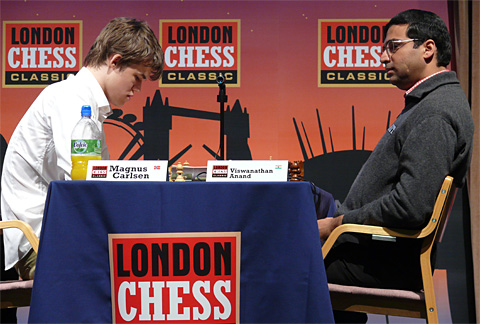
The game between Anand and Carlsen was a dramatic duel in the Breyer variation of the Spanish with many ups and downs. With a pawn sacrifice soon after the opening, the world champion tried to swing the chances to his side. It was risky, but Carlsen failed to find several good defenses and Anand had him on the ropes. Although the Indian grandmaster missed stronger continuations, he was able to come up with the winning setup in the end.
Anand - Carlsen
London Chess Classic 2010, Round 3
1.e4 e5 2.Nf3 Nc6 3.Bb5 a6 4.Ba4 Nf6 5.0-0 Be7 6.Re1 b5 7.Bb3 d6 8.c3 0-0 9.h3 (The starting position of the Closed Spanish.) 9...Nb8 (Swinging the knight via b8 to d7 to protect the pawn on e5 is an idea of a talented Hungarian master Gyula Breyer. It dates back to 1920. At the end of the 19th century, the first world champion William Steinitz and his rival, Mikhail Chigorin, also protected the pawn on e5 with a knight, but they did it rather clumsily with the knight from f6.) 10.d4 Nbd7 11.Nbd2 Bb7
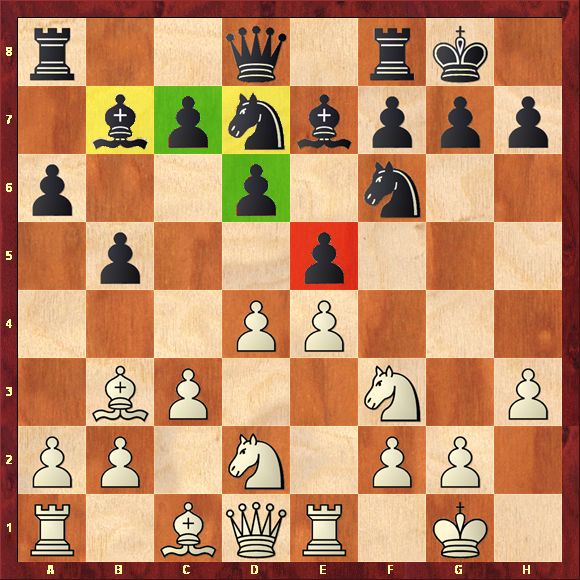
(We can see the elegance and flexibility of Breyer's setup: the knight on d7 protects the center, the bishop on b7 attacks it. The c-pawn is not hindered and can advance any moment. In addition, black may also strike in the center with d6-d5. ) 12.Bc2 Re8 13.a4 (White is at a crossroads. Swinging the knight to the kingside 13.Nf1 Bf8 14.Ng3 was the usual popular plan, but after 14...g6 white needed to open a second front and played 15.a4 c5 16.d5 and with the center closed, white can use his space advantage to prepare a combined attack on both wings. The first game between Bobby Fischer and Boris Spassky in 1992 comes immediately to mind. Blacks later realized that after 15.a4 keeping the center flexible with 15...Bg7 16.Bd3 c6 is not a bad idea.) 13...Bf8 14.Bd3 c6 15.b4 Rc8!? (A new, good waiting move. Carlsen previously played 15...Nb6 against Anand, clarifying the matters on the queenside immediately, but after 16.axb5 cxb5 17.d5 white had the edge.) 16.axb5 cxb5 17.Bb2 (White is ready to close the center with 18.d5 and black has to react.)
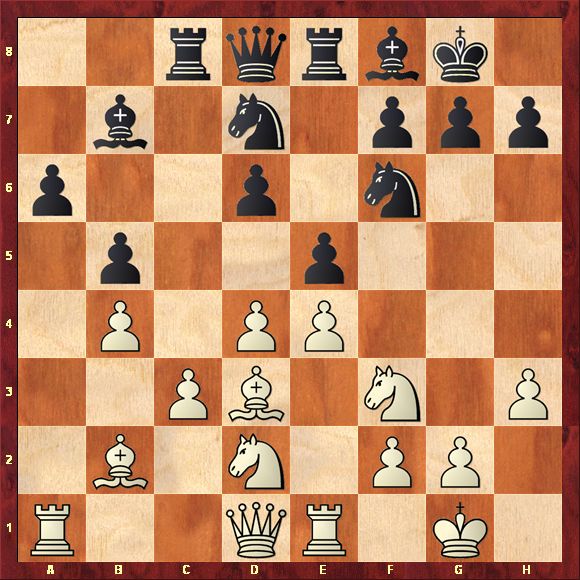
17...d5! (And just like that black equalizes. After the pawns disappear from the center, black's pieces will be well placed.) 18.exd5 (After 18.dxe5 dxe4 19.Nxe4 Nxe5 20.Nxe5 Rxe5 21.Nxf6+ Qxf6 black has a slight edge.) 18...exd4 19.Rxe8 (After 19.Nxd4 Nxd5 the black pieces have a larger playground.) 19...Qxe8 20.c4 (By advancing the c-pawn Anand can eliminate all pawns on the queenside. Everybody expected a quick draw.) 20...bxc4 21.Nxc4?! (Anand gambles and sacrifices a pawn. After 21.Bxc4 Nb6 22.Bxa6 Bxa6 23.Rxa6 Nbxd5 24.Nxd4 Bxb4 there is not much to play for.) 21...Nxd5 22.Nxd4 Nxb4 23.Nf5 (Anand moves his knight to an aggressive position, hoping for some attacking chances. But the legendary grandmaster David Bronstein claimed that the bishop on f8 can defend well against the knight on f5. Let's see...) 23...Nxd3 24.Qxd3
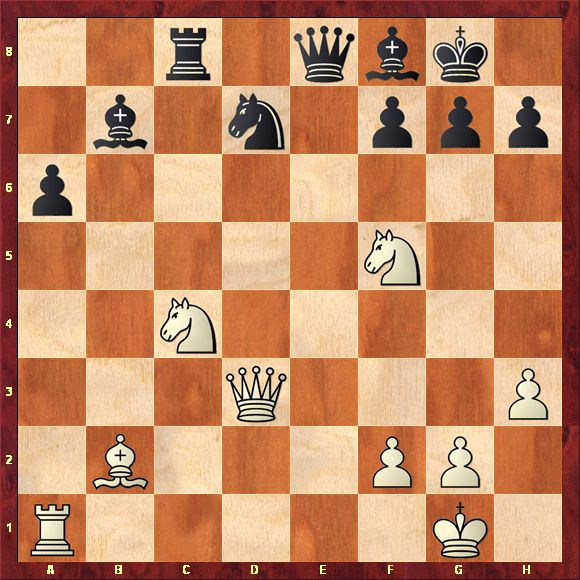
24...Be4? ("A huge oversight," said Carlsen, but fork is a fork and it could be a choice of many club players since Anand's little combination is not obvious. Still, Magnus should have played 24...Qe6! 25.Ncd6 Rc5 26.Nxb7 Rxf5 with black's advantage.) 25.Qd4 Bxf5?! (Sacrificing the queen with 25...Qe6!? 26.Ncd5 Rb8 27.Re1 Bxf5 28.Rxe6 Bxe6 gives black good chances to hold.) 26.Nd6 (Forking the whole army of black pieces, Anand gets a strong pressure.) 26...Qd8 (After 26...Bxd6?? 27.Qxg7 mates; and after 26...Qe6 27.Nxc8 Nc5 28.Ba3 Qxc8 [or 28...Nb3 29.Qd8 Qxc8 30.Rd1! h5 31.Bxf8] 29.Rc1 Be7 30.Bxc5 white should win.) 27.Nxf5 (A critical position. White threatens 28.Nh6+!)
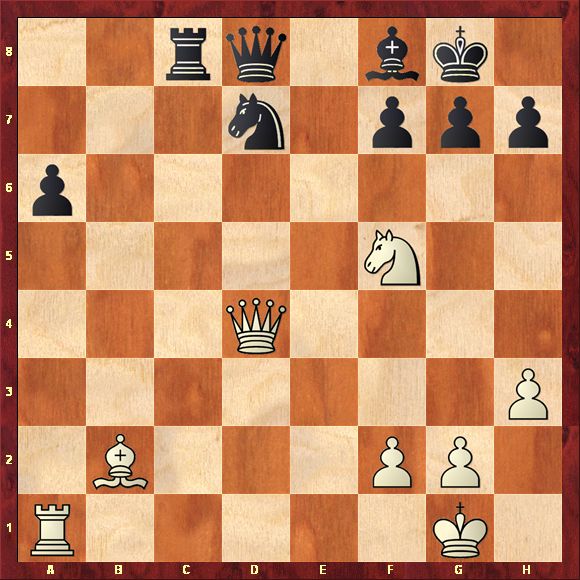
27...f6? (Black can't recover after this mistake. Instead, Magnus had two possibilities to stay in the game:
A. 27...Qf6 28.Qxf6 Nxf6 29.Bxf6 gxf6 30.Rxa6 is unpleasant for black, but the material is reduced and there is hope, for example 30...Rc5 31.g4 [31.Rxf6 Bg7 =] 31...h5 32.Rxf6 hxg4 33.hxg4 Rc4 34.f3 Rc2;
B. The computers want to fight back with 27...Rc6 28.Nxg7 Qb6! forcing the exchange of queens.) 28.Rd1 Rc2 (Carlsen defends aggressively. He probably didn't like that after 28...Rc7 29.Qd5+ Kh8 30.Qf7 his pieces are pinned down.) 29.Nh6+! (It didn't take Anand long to claim a big advantage.) 29...gxh6 (After 29...Kh8 30.Nf7+ wins.) 30.Qg4+ Bg7?! ( Magnus should have made it more difficult for white with 30...Kh8 31.Rxd7 Qxd7 32.Bxf6+ Qg7 33.Bxg7+ Bxg7, although after 34.Qe6 Bf8 35.Qf5 Rc1+ 36.Kh2 Bg7 37.Qe6 Ba1 [37...Bf8 38.Qe5+ Kg8 39.Qg3+ Kh8 40.Qb8 Kg8 41.Qb3+ Kh8 42.Qb2+ wins the rook.] 38.Qe8+ Kg7 39.Qe7+ Kg8 40.f4 white has winning chances.) 31.Qe6+ Kh8 32.Rxd7 Qf8
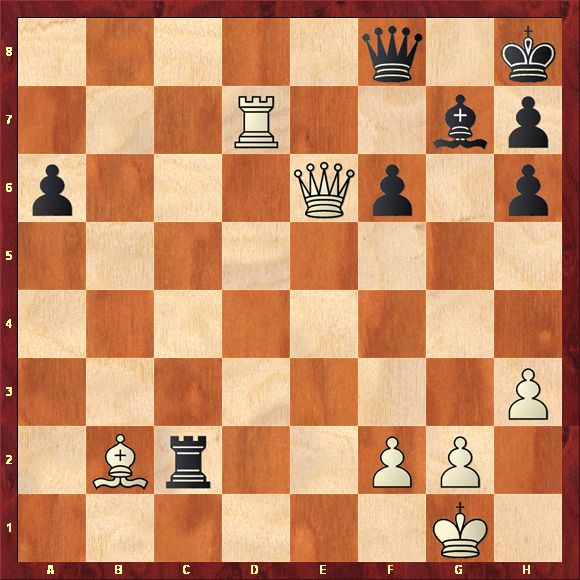
33.Ba3? (A ghost of the famous game Botvinnik-Capablanca, AVRO 1936, where similar deflecting sacrifice was decisive. But here Anand floats away from a direct win: 33.Rf7! , for example:
A. 33...Qb8 34.Re7 Rc8 35.Rxg7 Qxb2 36.Qf7 Qa1+ 37.Kh2 Qe5+ 38.f4 Qxf4+ 39.Rg3 Qxg3+ 40.Kxg3 Rg8+ 41.Kh4 Rxg2 42.Qf8+ Rg8 43.Qxf6+ Rg7 44.Qe5! a5 [44...Kg8 45.Qe8 mate.] 45.Kh5 a4 46.Kxh6 a3 47.Qxg7 mate.
B. 33...Qc8 34.Qe7 Rc1+ 35.Kh2 Qb8+ 36.g3 Rc2 37.Bd4 Qg8 38.Qxf6! Bxf6 39.Bxf6+ Qg7 40.Rf8 mate.)
33...Qg8 (33...Qxa3 is not entirely clear, for example 34.Rd8+ Qf8 [On 34...Bf8 35.Qxf6+ Kg8 36.Qe6+ Kh8 37.Qf7 Rxf2 38.Kxf2 wins.] 35.Rxf8+ Bxf8 36.Qxf6+ Kg8 black can try to fight.) 34.Qxa6 (Black will have a hard time to protect the last two ranks and the f-pawn.) 34...Qe8 35.Qa7! Qg8 (Black is forced to defend passively. After 35...Qe1+ 36.Kh2 Qe5+ 37.g3 Qe8 38.Rxg7 wins.)
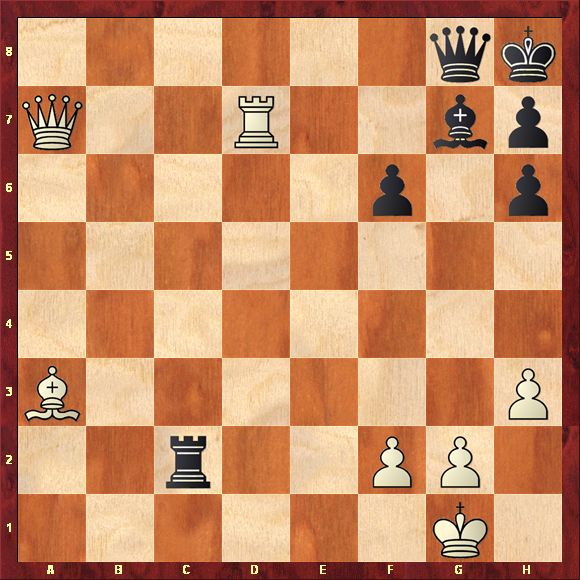
36.Be7?! (Anand could have cut off the black rook with 36.Bc5! and only after 36...Re2 37.Be7 threaten to win with 38.Rd8.) 36...Rc8 37.Qa6 Qe8 38.Ra7 Kg8 39.Qe6+ (But not 39.Bxf6? Bxf6 40.Qxf6 Rc1+ 41.Kh2 Qb8+ and black (!) wins.) 39...Kh8 40.Qa6 Kg8 41.Qe6+ (The time control is over and Anand can assess the position. Black's pawns on the kingside are shattered, but can white mount a successful siege of the pawn f6 and win it? The problem is that black can't do anything. Carlsen has to wait for Anand to demonstrate how to set up the pieces the best way.) 41...Kh8 42.Kh2 Rc6 (After 42...Ra8 43.Rc7 white keeps the pressure on.) 43.Qb3 Rc8 44.Bd6 Qg6 45.Qb7 Rd8 46.Bg3 Rg8 47.h4 Qf5 48.Qc7 Qd5 49.Ra5 Qe4 50.Qd7 Qc4 51.Qf5 Qc8 52.Qf3 Qd7 53.Bf4 Qf7 54.g3 Re8 55.Be3 Rg8 56.Ra6 Re8 57.Ra7 Re7 58.Qa8+ Qf8 59.Ra6 Re8 60.Qc6 Rc8 61.Qf3 Qf7 62.Ra7 Qe6 63.Qb7 Qg8 64.Bf4 Rd8 65.Qa6 Re8 66.Rc7 Ra8 67.Qc6 Re8 68.Be3 Rb8 69.Bd4
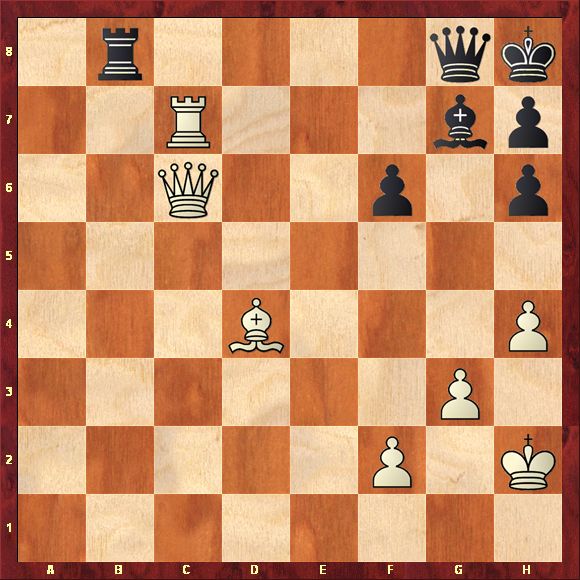
(Anand found the ideal position. White combines the attack on the pawn on f6 with the threats on the 8th rank.) 69...Qf8 (After 69...Rf8 70.Re7 Rf7 71.Re6 f5 [or 71...Rf8 72.Rxf6 Rxf6 73.Qxf6 wins.] 72.Qc3 f4 73.Bxg7+ Rxg7 74.Qe5 wins.) 70.Qc3 Re8 71.Rc6 (Picking up the pawns.) 71...Qf7 (After 71...f5 72.Rc7 wins.) 72.Bxf6 Rf8 (Black also loses after 72...Kg8 73.Bxg7 Qxg7 74.Qd2 h5 75.Rc5+-) 73.Bxg7+ Qxg7 74.Qe3 Qb2 75.Kg2 Qb7 76.Qxh6 Qf7 (After 76...Rc8 77.Qf6+ Kg8 78.Qe6+ wins.) 77.Rc2 Black resigned.
Note that in the replay windows below you can click on the notation to follow the game.
The solutions to last week's puzzles:
Note that in the replay windows below you can click on the notation to follow the game.
Note that in the replay windows below you can click on the notation to follow the game.
We recieved this response:
Dear Lubosh,
I refer to Noam Elkies' Chess Puzzle. Chess Life 1985, solution to which you furnished today.
Did I find a cook? After 1.Bg6, what if 1...d4? So that if 2.e8Q+ Bg8 3.Bh7 Bc1+ 4.Kc2 (if 4.Kxc1 g1Q+) Kxh7 5.Qh5+ Bh6?
Warmest regards,
Elmer Dumlao Sangalang
Manila, the Philippines
Answer: Instead of 3.Bh7, try 3.Bf7. White wins. Thanks for your interest in this column.
Photo by Frederic Friedel
No comments:
Post a Comment